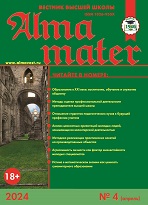https://doi.org/10.20339/AM.1-18.077
E.V. Romanov is Dr.Sci. (Pedagogy), prof. e-mail:evgenij.romanov.1966@mail.ru; and E.V. Romanova is post-graduate student e-mail: catrin.vladimirovna@yandex.ru at Magnitogorsk State Technical University n.a. G.I. Nosov
The long-term forecast of development of the higher education till 2026 is submitted. Potential risks of the human capital of state universities are defined by discrepancy of real financing of the higher education to the standards es-tablished by the law "About Education in the Russian Federation", possible decrease in number of the faculty to 192,9 thousand people by 2018/19. On the basis of the offered new approach to carrying out and representation of results of the strategic analysis as backbone component of strategy of the organization is proved that the higher education institutions having the stable number of PPS with a big specific share of PPS to 40 years can resist to rather effectively existing threats. Reduction of PPS against the background of decrease in specific weight of PPS up to 40 years in the total number of teachers assumes two alternatives: reduction of number of the realized educational programs or increase in number of the disciplines having on 1 PPS and inevitable falling of quality of education.
Key words: strategic analysis, “return” SWOT analysis, long-term forecast.
References
1. Romanov, E.V. Financing of high schools aimed at stimulation of innovative approach. University administration: practice & analysis. 2015, no. 4 (98), pp. 87-105.
2. Romanov, E.V. Management in innovative development at high school. Vestnik of university. 2013, no. 15, pp. 91–98.
3. Sheregi F.E., Rybakovskiy L.L. i dr.Number of students and personnel of educational institutions of the RF. Prognosis for 2020 and evaluation of tendencies up to 2030. Moscow, 2013, р. 164.
4. Sheregi, F.E., Aref'ev, A.L. i dr. Number of students, pedagogical personnel and professor staff, number of educational organizations of the RF. Prognosis up to 2020 and evaluation of tendencies up to 2020. Moscow, 2015.
5. Klyachko, T.L. New tendencies of development of education. University administration: practice and analysis. 2016, no. 5 (105), pp. 28–35. DOI 10.15826/umj.2016.105.041
6. Romanov, E.V. Methodology and theory of innovative development of higher education in Russia. Moscow, 2016, р. 302.
7. Federal organ of state statistic. Interactive supplements. Age and gender pyramid. URL: http://www.gks.ru/wps/wcm/connect/rosstat_main/rosstat/ru/apps
8. Federal organ of state statistic. Demography prognosis up to 2030. URL: http://www.gks.ru/wps/wcm/connect/rosstat_main/rosstat/ru/statistics/pop...
9. Russian statistical year-book. 2016. Moscow, 2016.
10. Romanov, E.V. Imperative of innovative development of higher education in Russia. Alma mater (Vestnik vysshei shkoly). 2015, no. 2, pp. 10–19.











.png)






